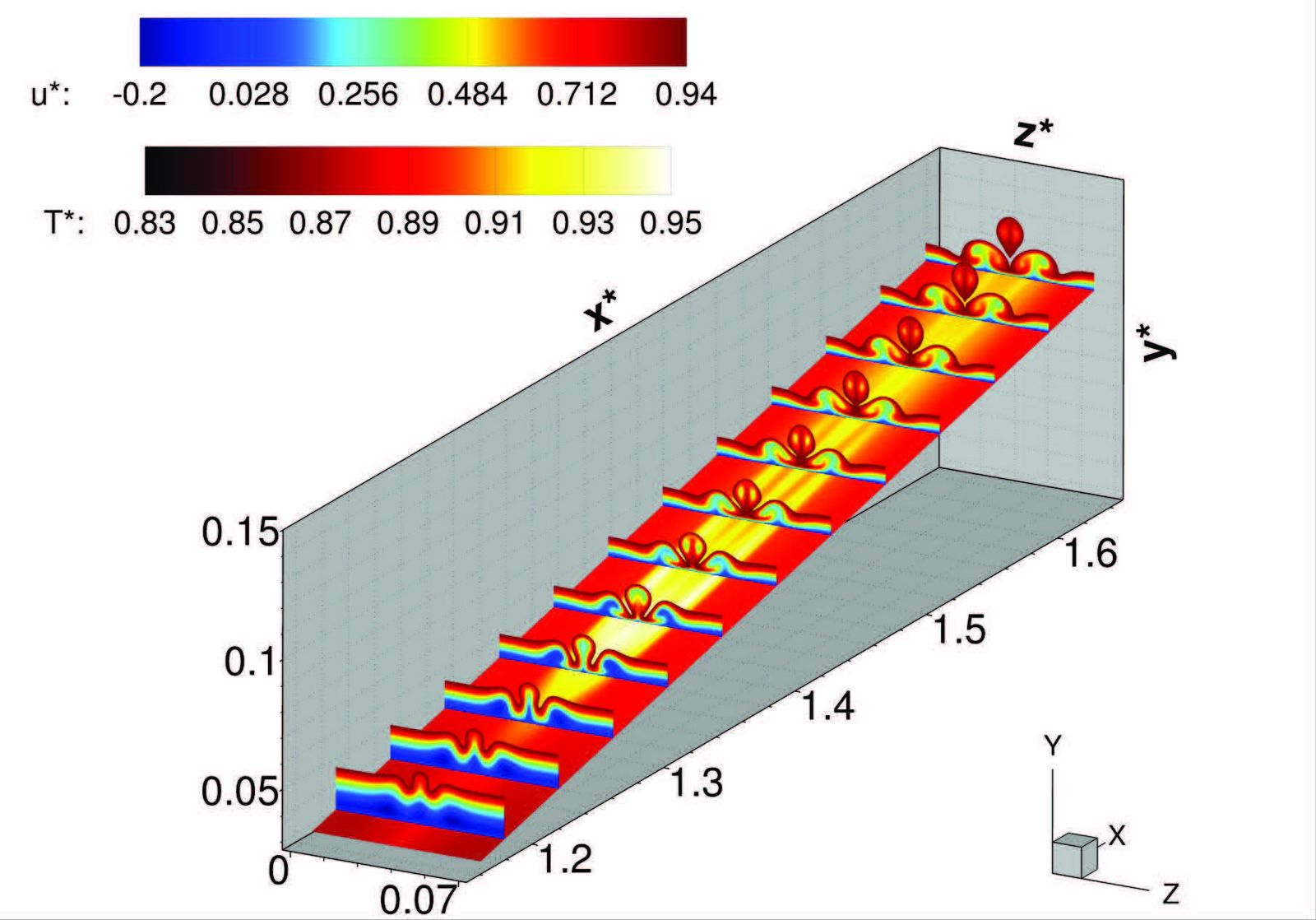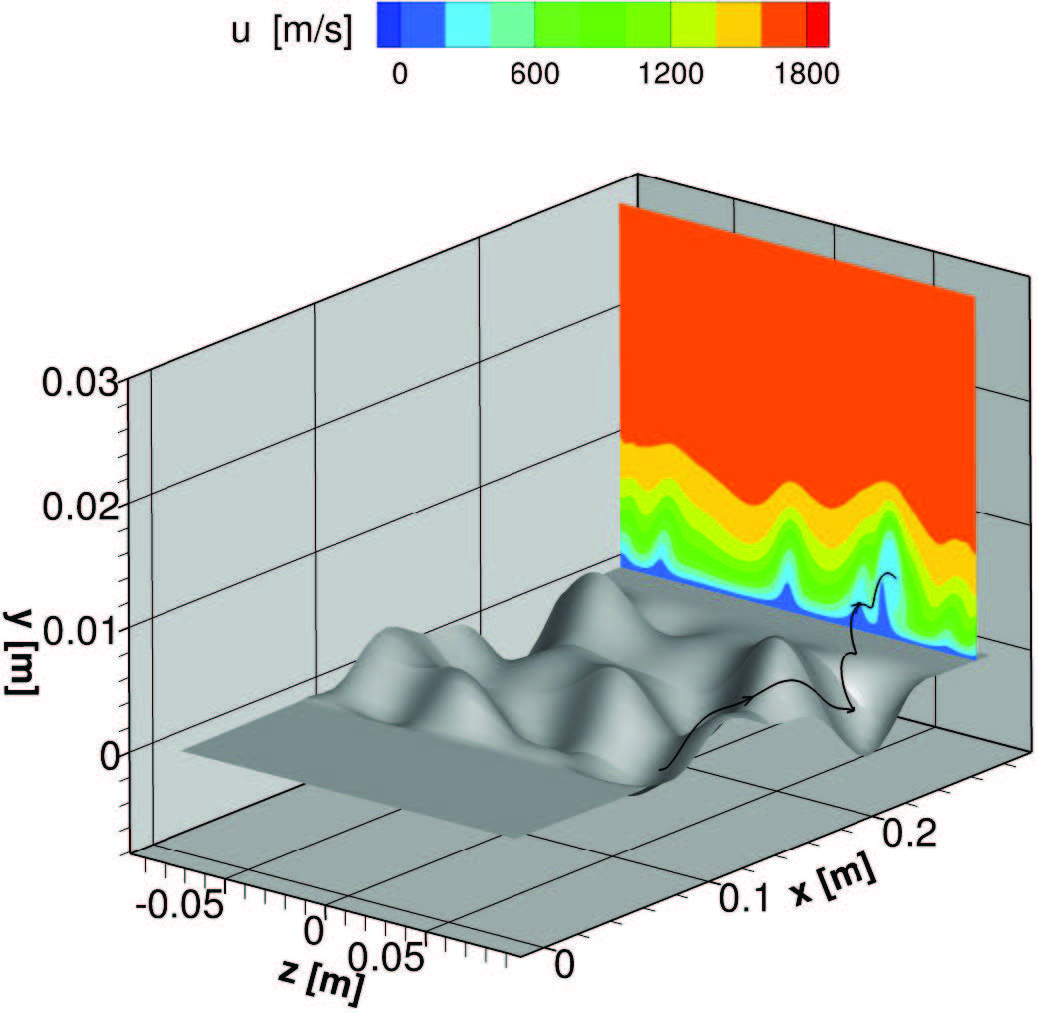ENGINEERING AND CFD
Roughness-induced Laminar-turbulent Transition for Hypersonic Vehicles
Principal Investigator:
Prof. Christian Stemmer
Affiliation:
Technische Universität München, Munich, Germany
Local Project ID:
pn36bi
HPC Platform used:
SuperMUC-NG PH1 CPU at LRZ
Date published:
Introduction
For the design of sustainable hypersonic flight at Mach numbers above 5 or re-entry vehicles like space capsules or the Space Shuttle, heat management is one of the crucial aspects of engineering. Besides the application of insulating materials and their development to be used in the heat shield, the generation of the heat through fluid dynamics processes in the boundary layer along the vehicle has to be known. As experiments for these flight conditions are either extremely expensive or subject to large errors, numerical simulations can bridge the gap between the lab environment and the full-scale application. Laminar-turbulent transition at hypersonic speeds is one of the key feature to understand the physics of the flow at high speeds and high temperatures as the heat load on the vehicle can change more than 10-fold if the flow becomes turbulent compared to a laminar flow. In this project, we investigate through high-precision and high-fidelity numerical simulations including chemical reactions (dissociation) and non-equilibrium the influence of surface imperfections on the laminar-turbulent transition. The surface roughness either comes from holes for screws, gaps between heat-shield tiles or from the ablating material subject to burning at these extreme temperatures.
Results and Methods
Two flow configurations have been studied, namely the compression-corner (or ramp) geometry, representative of control surfaces or engine intakes of a hypersonic vehicle, and an Apollo-like capsule geometry. In both cases, surface roughness was modeled at specific locations (upstream of the compression corner and on the shoulder of the capsule, respectively) to study its influence on the downstream evolution of the high-speed boundary layer. The Direct Numerical Simulations are performed with the code NSMB, which allows to make full use of the parallel-computing capabilities of SuperMUC-NG. In the first configuration, the roughness shows a dramatic impact on the ramp-induced Shock-Wave/Boundary-Layer Interaction (SWBLI). The roughness induces the formation of streamwise vortices in its wake, which are convected downstream in the boundary layer. Once the flow separates due to the corner-induced shock and then reattaches on the ramp, the vortices are strongly amplified and generate a mushroom-shaped structure characterized by large velocity gradients (Figure 1, taken from [1]). Underneath this vortical structure, hot streaks appear at the wall, where the surface temperature reaches values much higher than those achieved without roughness. As known from the literature [2,3,4], strong roughness-induced velocity gradients can lead to flow instabilities that can initiate the transition process. Hence, a similar flow evolution can be expected in the reattached flow on the ramp, once freestream disturbances are injected in the baseflow. For the space capsule configuration, our research focused on a restricted domain specifically targeted at the shoulder region of the Apollo-like spacecraft. This region exhibits a high concentration of observed turbulent spots, making it a critical area for analysis. An example of such a restricted domain can be found in Fig. 2 from [5]. It displays a random roughness patch and cross-flow-like vortex formed in the wake region of the roughness-patch. To explore the impact of surface roughness on flow transition, we generated a comprehensive database which consists of over 10,000 Direct Numerical Simulations (DNS) results. Each simulation featured unique, individually randomized roughness patches, crafted using a superposition of three distinct wave-numbers. This approach aimed at modeling surface imperfections, akin to those encountered during the ablation process of an actual re-entry flight. Our analysis delved into the crossflow-like vortices generated downstream of each roughness patch [6]. These vortices play an important role in flow transition, and under-standing their formation process was paramount. Furthermore, we investigated the potential of machine learning (ML) in quantifying the strength of these crossflow-like vortices. We evaluated various ML algorithms, ultimately achieving the most promising results with a multi-layer perceptrons and convolutional neural networks. This integration of ML offers exciting possibilities for future research and real-time monitoring of re-entry conditions. The complete DNS database as well as our ML models can be downloaded and used from our GIT repository [7].

Figure1: Mushroom-shaped structure forming in the wake of the roughness as the flow reattaches on the ramp.

Figure 2: Restricted domain with a random distributed roughness patch and a cross-flow-like vortex in the wake.
Ongoing Research / Outlook
On the ramp-induced SWBLI side, the current efforts focus on the unsteady response of the roughness-modified baseflow to different types of freestream disturbances prescribed upstream of the flow interaction with the corner shock. The study aims at characterizing the mechanisms, specifically associated with the presence of surface roughness, that lead to laminar-turbulent transition downstream of reattachment. For the capsule, our future work expands upon this investigation, exploring the influence of higher-complexity roughness patches on re-entry flow. We will incorporate a broader range of wavelengths, amplitudes, and phases within the random roughness model, striving for enhanced realism in representing ablated heatshields. High-resolution CFD simulations will delve deeper into the flow dynamics, offering refined insights into turbulence initiation and heat transfer. Additionally, we made our improved DNS data-base public [7], facilitating further research and model development. We want to find more partners in order to expand our database. Finally, we aim to advance our machine learning models using sophisticated algorithms to improve the accuracy and efficiency of crossflow-like vortex characterization. This comprehensive approach will contribute to a deeper understanding of the blunt body paradox, ultimately promoting safer and more predictable re-entry experiences.
References and Links
[1] G. Chiapparino, C. Stemmer, Int. J. Heat & Fluid Flow, 103:109193, 2023.
[2] P. Wassermann, M. Kloker. J. Fluid Mech. 456, 49-84, 2002.
[3] G.Groskopf et al.In:Proceedings ofthe SummerProgram 2008 Center for Turbulence Research, pp. 55-72.
[4] G. Groskopf, M. Kloker, O. Marxen. In: 7th IUTAM Symposium on Laminar-Turbulent Transition, pp. 171-176.
[5] F. Ulrich and C. Stemmer, CEAS Space Journal, 2023, 971988 (2023), doi: 10.1007/s12567 023-00510-2.
[6] A. Di Giovanni et al., J. Fluid Mech. (Vol. 856), 2018.
[7] https://gitlab.lrz.de/fulrich/dns-roughness-database-for-ai